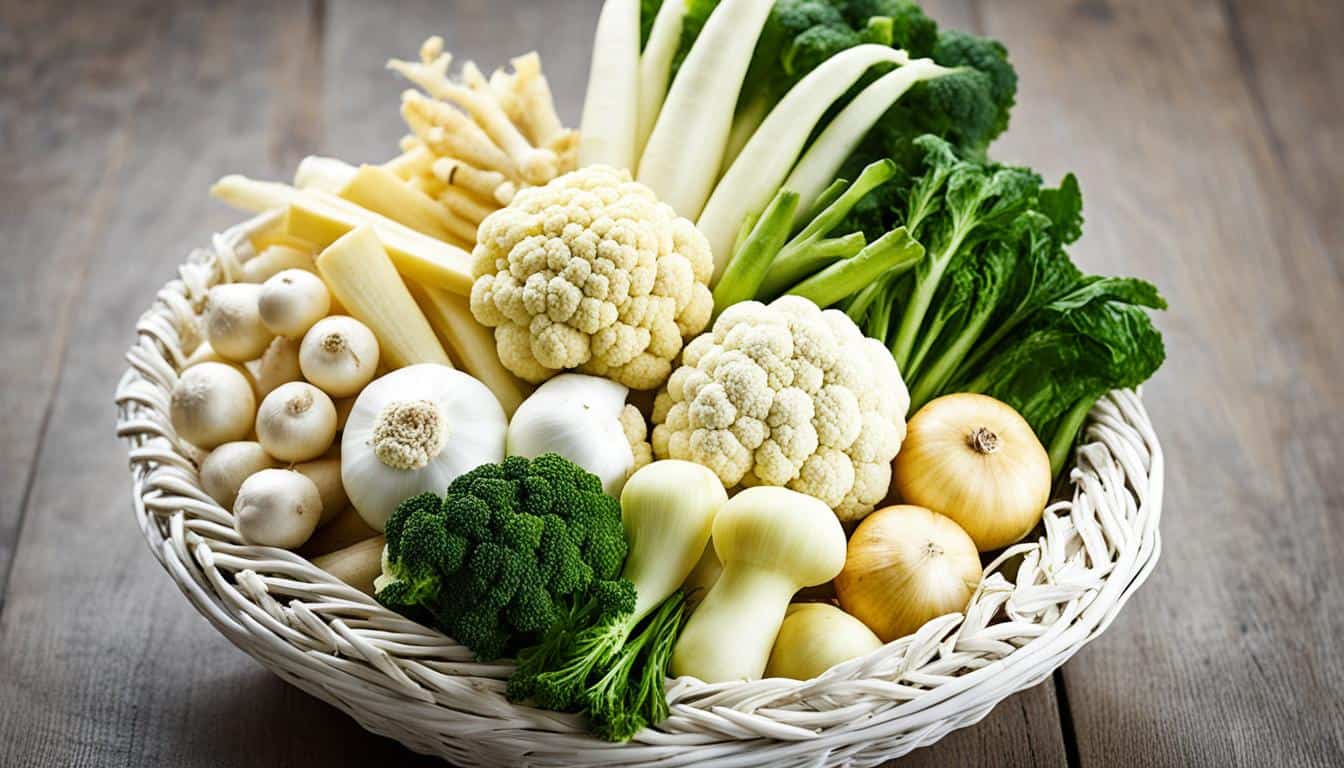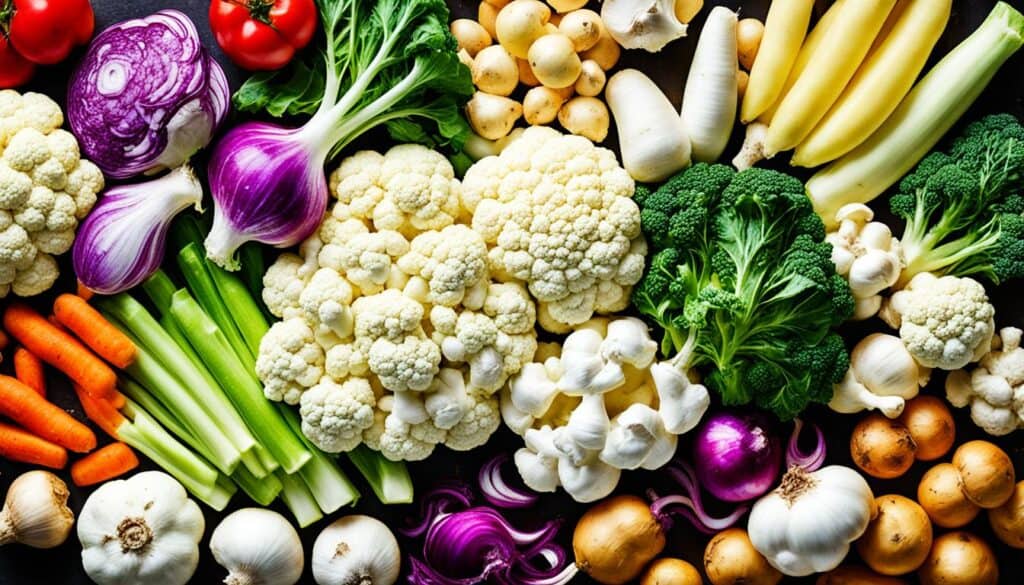Did you know that naturally white vegetables are often overlooked despite being packed with essential vitamins and minerals? While processed white foods may not be the healthiest choice, white vegetables like cauliflower and garlic offer a range of nutritional benefits. These white superstars deserve a spot on your plate alongside their colorful counterparts!
Key Takeaways:
- White vegetables like cauliflower and garlic are often underrated but offer a wealth of vitamins and minerals.
- While processed white foods should be consumed in moderation, naturally white vegetables can contribute to a healthy diet.
- Incorporating white vegetables into your meals can provide specific compounds like allicin and vitamin D.
- Research suggests that consuming white vegetables may be associated with a reduced risk of strokes.
- Include a variety of white vegetables in your meal planning to increase nutrient intake and support overall health.
Are White Vegetables Equally Beneficial?
When it comes to eating a healthy and balanced diet, the focus is often on consuming a diverse range of colorful fruits and vegetables. However, it’s important not to overlook the nutritional value of white vegetables. While colorful produce is known for being rich in antioxidants and vitamins, white vegetables have their own unique benefits that contribute to overall health and wellness.
White vegetables are generally high in fiber, which is essential for digestive health and can help promote satiety. Additionally, they contain a variety of important vitamins and minerals that support various bodily functions. For example, garlic, a popular white vegetable, contains allicin, a compound known for its potential immune-boosting and cardiovascular health benefits. Mushrooms, another white vegetable, are a great source of vitamin D, which plays a crucial role in bone health and immune function.
By incorporating white vegetables into your diet, you can ensure a well-rounded nutrient intake and take advantage of the specific benefits they offer. Eating a variety of vegetables, including white ones, provides a diverse array of vitamins, minerals, and antioxidants that support overall health and well-being.
Benefits of Eating White Vegetables
“Including white vegetables in your diet can provide important nutrients and unique compounds that contribute to your overall health.”
Here are some key benefits of eating white vegetables:
- High fiber content: White vegetables are typically high in fiber, which aids digestion and promotes bowel regularity.
- Essential vitamins and minerals: White vegetables contain important vitamins and minerals that support various bodily functions, such as vitamin D in mushrooms and allicin in garlic.
- Immune-boosting properties: Garlic, a white vegetable, is known for its potential immune-boosting properties, thanks to the presence of allicin.
- Bone health support: Mushrooms, particularly white button mushrooms, are one of the few plant sources of vitamin D, which is essential for strong bones and immune system functioning.
By incorporating white vegetables like garlic and mushrooms into your meals, you can reap the nutritional benefits they offer and support your overall health.
| White Vegetable | Nutritional Benefits |
|---|---|
| Garlic | Contains allicin, which has immune-boosting and cardiovascular health benefits. |
| Mushrooms | Natural source of vitamin D, crucial for bone health and immune function. |
| Cauliflower | Rich in vitamin C, fiber, and antioxidants that support overall health. |
| Onions | Contain antioxidants and sulfur compounds that may help lower cholesterol levels and support heart health. |
By including these white vegetables in your diet, you can enjoy their unique nutritional benefits and contribute to your overall well-being.
Nutritional Value of White Vegetables
When it comes to nutrition, white vegetables such as garlic and mushrooms pack a powerful punch. These humble veggies offer specific compounds that contribute to our overall health and well-being.
The Power of Allicin in Garlic
Garlic, with its pungent aroma and distinct flavor, is well-known for its culinary uses. However, it also contains a compound called allicin, which has been extensively studied for its potential health benefits. Allicin is known for its immune-boosting properties and its ability to support cardiovascular health.
Research suggests that allicin may have antimicrobial, anti-inflammatory, and antioxidant effects, making it a valuable addition to our diet. By incorporating garlic into our meals, we can enjoy its unique flavor while reaping the benefits of allicin.
Vitamin D in White Mushrooms
While sunlight remains the primary source of vitamin D for our bodies, white mushrooms offer a rare plant-based option. These versatile fungi are one of the few natural sources of vitamin D, an essential nutrient for bone health and immunity.
Vitamin D plays a crucial role in calcium absorption, promoting strong bones. Additionally, it supports our immune system, helping to defend against infections and regulate inflammatory responses.
Including white mushrooms in our meals allows us to incorporate vitamin D into our diet, especially for those who have limited sun exposure or follow a plant-based lifestyle.
“Garlic is rich in allicin, which boosts our immune system and supports cardiovascular health. White mushrooms provide vitamin D, which is essential for bone health and immunity.”
The Nutritional Value of White Vegetables
To better understand the nutritional value of white vegetables, let’s take a closer look at the key nutrients found in garlic and mushrooms:
| White Vegetable | Nutrients |
|---|---|
| Garlic | Allicin, vitamin C, manganese, selenium |
| White Mushrooms | Vitamin D, potassium, copper |
As the table demonstrates, white vegetables offer a range of essential nutrients. Garlic not only provides allicin but also contains vitamin C, manganese, and selenium. On the other hand, white mushrooms are a rich source of vitamin D, potassium, and copper.
By incorporating these nutrient-rich white vegetables into our meals, we can enhance our overall nutrient intake and support our health.
White Vegetables for Reduced Stroke Risk
Consuming white vegetables can have a positive impact on your cardiovascular health and reduce the risk of strokes. Research findings suggest that incorporating white vegetables into your diet can lower the occurrence of strokes by up to 9%. This highlights the potential protective effect of white vegetables and emphasizes their importance in maintaining a balanced and nutritious eating plan.
Stroke is a serious medical condition that occurs when blood flow to the brain is interrupted, leading to damage or death of brain cells. Incorporating white vegetables in your diet may help lower the risk of stroke and promote overall cardiovascular health. Including a variety of white vegetables in your meals can provide essential nutrients and contribute to the prevention of stroke-related complications.
The Connection Between White Vegetables and Stroke Risk
“A study published in the journal Neurology found that individuals who consumed a higher amount of white vegetables had a significantly decreased risk of stroke compared to those who consumed fewer white vegetables.”
White vegetables, such as cauliflower, onions, potatoes, turnips, and mushrooms, offer various health-promoting compounds that may contribute to the reduced risk of strokes. These vegetables are rich in vitamins, minerals, and antioxidants, which are known to play a crucial role in maintaining a healthy cardiovascular system.
While the exact mechanisms behind the association between white vegetables and stroke risk reduction are still being studied, it is believed that their beneficial effects are mediated through several factors. These may include:
- Antioxidant properties that help protect against oxidative stress and inflammation
- High fiber content, which supports healthy cholesterol levels and aids in weight management
- Phytochemicals that have positive effects on blood vessels and blood flow
By incorporating white vegetables into your diet, you can proactively support your cardiovascular health and decrease the risk of strokes.
| White Vegetables | Benefits |
|---|---|
| Garlic | Contains allicin, which has been associated with cardiovascular health benefits |
| Potatoes | Rich in potassium, which helps regulate blood pressure |
| Cauliflower | High in antioxidants and fiber, promoting heart health |
| Mushrooms | A good source of vitamin D, which plays a role in cardiovascular health |
| Onions | Contain flavonoids and sulfur compounds that promote heart health |
Including these white vegetables in your meals can provide a wide range of nutrients that contribute to overall well-being. Whether roasted, steamed, or included in soups, white vegetables are versatile and can be incorporated into various recipes to suit your taste preferences.
By maintaining a balanced diet that includes an assortment of white vegetables, you can take proactive steps toward reducing the risk of strokes and promoting optimal cardiovascular health.
Healthful White Vegetables to Include in Your Diet
When it comes to incorporating white vegetables into your meals, there are several options that offer a host of health benefits. These white vegetables not only provide nutrition but also add flavor and variety to your dishes. Let’s explore some of the top white vegetables to include in your diet:
Garlic
Garlic is well-known for its immunity-boosting properties and cholesterol-lowering effects. It contains allicin, a beneficial compound that has been studied for its potential to enhance the immune system and support heart health. Adding fresh or roasted garlic to your meals can not only enhance the flavor but also provide a range of health benefits.
Onions
Onions are not only a versatile ingredient in the kitchen but also offer numerous health benefits. They are rich in antioxidants and sulfur compounds, which can help reduce inflammation and support overall health. In addition, onions may help balance cholesterol levels and support heart health.
Potatoes
Potatoes often get a bad rap, but they can be a healthy addition to your diet when prepared in a nutritious way. They are a good source of vitamin C, which supports the immune system, and potassium, which plays a crucial role in maintaining healthy blood pressure levels. By opting for healthier cooking methods like baking or boiling instead of frying, you can enjoy the health benefits of potatoes without the added calories.
Turnips, Parsnips, and Rutabagas
These root vegetables may not be as well-known as others, but they offer a range of vitamins and minerals. Turnips are rich in vitamin K, which is important for blood clotting and bone health. Parsnips contain fiber, vitamin C, and several other essential nutrients. Rutabagas are an excellent source of vitamin C, fiber, and potassium. Including these vegetables in your meals can add variety and provide essential nutrients for optimal health.
Mushrooms
Mushrooms, especially white button mushrooms, are a delicious addition to any dish. They not only add flavor and texture but also provide a unique set of nutrients. Mushrooms are one of the few plant-based sources of vitamin D, which is essential for bone health and immune function. They also contain B vitamins that play a role in energy production and brain health.
Cauliflower
Cauliflower has gained popularity as a versatile vegetable that can be used as a low-carb alternative in various dishes. It is rich in vitamins C and K, fiber, and antioxidants. Cauliflower can be roasted, mashed, riced, or even used as a pizza crust or rice substitute, making it a great option for those looking to reduce their carbohydrate intake.
Celeriac
Celeriac, also known as celery root, may not be as commonly used as other white vegetables, but it offers unique health benefits. It has a creamy texture and a slightly nutty flavor, making it a great addition to soups or stews. Celeriac is rich in B vitamins and vitamin K, which are essential for overall health and wellbeing.
Incorporating these healthful white vegetables into your diet can provide a range of benefits, from boosting immunity to supporting heart health and improving nutrient intake. Experiment with various cooking methods and recipes to discover new ways to enjoy the flavors and benefits of these white vegetables.
Cooking Tips for White Vegetables
The way we prepare white vegetables can greatly impact their nutritional value. While some nutrients may be lost during cooking, others can be enhanced, making them even more beneficial for our health. Here are some cooking tips to maximize the nutrition of white vegetables:
Cooking Methods
When it comes to preserving the nutrients in white vegetables, it’s generally recommended to eat them raw or lightly steamed. These methods help retain the most vitamins and minerals. However, if you prefer cooked white vegetables, there are still healthful benefits to be gained.
Enhancing Nutrient Availability
Certain cooking techniques can actually increase the availability of nutrients in white vegetables. For example:
- Crushing or chopping garlic activates the allicin compound, which is known for its immune-boosting and cardiovascular health benefits.
- Cooking cruciferous vegetables like cauliflower can enhance the development of cancer-fighting compounds, such as sulforaphane.
- Beta-carotene in white vegetables like carrots becomes more available for absorption after cooking.
Cooking Tips for Specific White Vegetables
Here are some specific cooking tips for popular white vegetables:
| White Vegetable | Cooking Tips |
|---|---|
| Garlic | Crush or chop garlic before cooking to activate its beneficial compounds. Add it to your dishes towards the end of the cooking process to preserve its flavor and health benefits. |
| Cauliflower | Steam or blanch cauliflower until it is tender but still slightly crisp. This helps retain its nutrients while ensuring a pleasant texture. |
| Mushrooms | Gently sauté or roast mushrooms to bring out their natural umami flavor and preserve their nutrient content. |
| Potatoes | Boil or bake potatoes until they are fork-tender. Avoid deep frying them to minimize the intake of unhealthy fats. |
Remember, cooking white vegetables can still provide healthful benefits, but be mindful of the cooking method and duration to preserve as much nutrition as possible.
The Importance of White Vegetables in a Balanced Diet
When it comes to a balanced diet, white vegetables should not be overlooked. While often overshadowed by their vibrant counterparts, white vegetables offer a range of essential nutrients that are often under-consumed by Americans. Incorporating white vegetables into your meals can help increase your nutrient intake and contribute to overall health and wellness.
White vegetables, such as potatoes, cauliflower, onions, and mushrooms, provide a variety of nutrients that are beneficial for the body. They are rich in fiber, which aids in digestion and helps maintain a healthy weight. Potassium, found in white vegetables like potatoes, helps regulate blood pressure and supports proper muscle and nerve function. Magnesium, another important mineral found in white vegetables, plays a vital role in over 300 biochemical reactions in the body.
By including a variety of vegetables in your diet, including white ones, you can ensure a well-rounded and nutritious eating plan. White vegetables can be enjoyed in various forms, whether roasted, sautéed, or steamed, adding flavor and texture to your meals. Here are some examples of commonly consumed white vegetables:
- Potatoes: A versatile vegetable that can be prepared in countless ways, potatoes are a good source of vitamin C, potassium, and fiber.
- Cauliflower: This cruciferous vegetable is not only delicious but also packed with vitamins C and K, as well as fiber and antioxidants.
- Onions: With their unique flavor, onions offer antioxidants, sulfur compounds, and other beneficial plant compounds that may support heart health.
- Mushrooms: White mushrooms, in particular, are a good source of vitamin D and B vitamins. They also offer antioxidants and may support immune function.
Including white vegetables in your diet can help fill nutritional gaps and ensure that you are meeting your body’s needs. These vegetables provide a range of healthful nutrients and can be easily incorporated into a variety of dishes. Whether as a main ingredient or a side dish, white vegetables are a valuable addition to a balanced diet.
Including White Vegetables in Meal Planning
When it comes to boosting your nutrient intake, incorporating more white vegetables into your meal planning can be a simple and effective strategy. Don’t let their pale appearance fool you; white vegetables like potatoes, cauliflower, onions, and turnips offer a range of health benefits. With a little creativity and healthy cooking techniques, you can make these white wonders an integral part of your nutritious and satisfying meals.
White potatoes: While potatoes sometimes get a bad rap, they can be part of a healthy meal pattern when prepared properly. Instead of loading them up with butter and salt, try using heart-healthy olive oil and herbs to enhance the flavor. You can also try baking or roasting them for a crispy and nutritious alternative. White potatoes are a good source of fiber and potassium, making them a valuable addition to your overall nutrient intake.
Cauliflower, onions, and turnips: These versatile white vegetables can be used in a variety of recipes to add depth and nutrition to your meals. Cauliflower can be riced or mashed as a low-carb substitute for rice or potatoes. Onions can be sautéed and added to soups, salads, or stir-fries for extra flavor and antioxidants. Turnips can be roasted or added to stews and casseroles for a satisfying and nutrient-packed addition.
I find that getting creative with white vegetables not only adds nutritional value to my meals but also makes them more interesting and delicious. Experimenting with different cooking methods and flavor combinations can unlock the true potential of white vegetables in your cooking.
Here are some ideas to inspire your healthy cooking with white vegetables:
- Make a creamy cauliflower soup with low-fat milk and herbs.
- Create a flavorful cauliflower rice stir-fry with a variety of colorful vegetables.
- Slice turnips into thin rounds and bake them with olive oil and spices for a nutritious snack.
- Add sautéed onions to your favorite omelet or frittata recipe for extra flavor.
- Roast a mix of white vegetables, such as cauliflower, turnips, and onions, with a drizzle of olive oil and your choice of herbs.
By including white vegetables in your meal planning, you can elevate your nutrition and enjoy the health benefits they offer. Don’t limit yourself to just green or colorful vegetables; embrace the goodness of white vegetables for a well-rounded and satisfying diet.
| White Vegetables | Health Benefits |
|---|---|
| White Potatoes | Good source of fiber and potassium |
| Cauliflower | Low-carb substitute for rice or potatoes |
| Onions | Rich in flavor and antioxidants |
| Turnips | Nutrient-packed addition to stews and casseroles |
The Potential of White Vegetables in Meeting Dietary Guidelines
When it comes to meeting the dietary guidelines, white vegetables can play a valuable role in ensuring we get the nutrients our bodies need. While there are specific recommendations for dark green and orange vegetables, we often overlook the potential benefits of white vegetables. With their rich fiber content, along with essential minerals like potassium and magnesium, white vegetables such as potatoes can contribute to a well-rounded nutrient intake.
White vegetables have long been overshadowed by their colorful counterparts, but research suggests that they shouldn’t be underestimated. Incorporating white vegetables into our diets can help address nutrient deficiencies that are all too common in the American diet. By including potatoes, cauliflower, and other white vegetables, we can improve our overall nutrient intake and align ourselves with the recommendations for a healthy diet.
White vegetables may not have their own dedicated recommendation in the dietary guidelines, but that doesn’t mean they should be ignored. In fact, by incorporating a variety of white vegetables into our meals, we can take a step closer to meeting the dietary guidelines’ goal of a diverse and balanced diet. So, let’s embrace the potential of white vegetables and make them a regular part of our nutrient-rich meals.










Leave a Reply